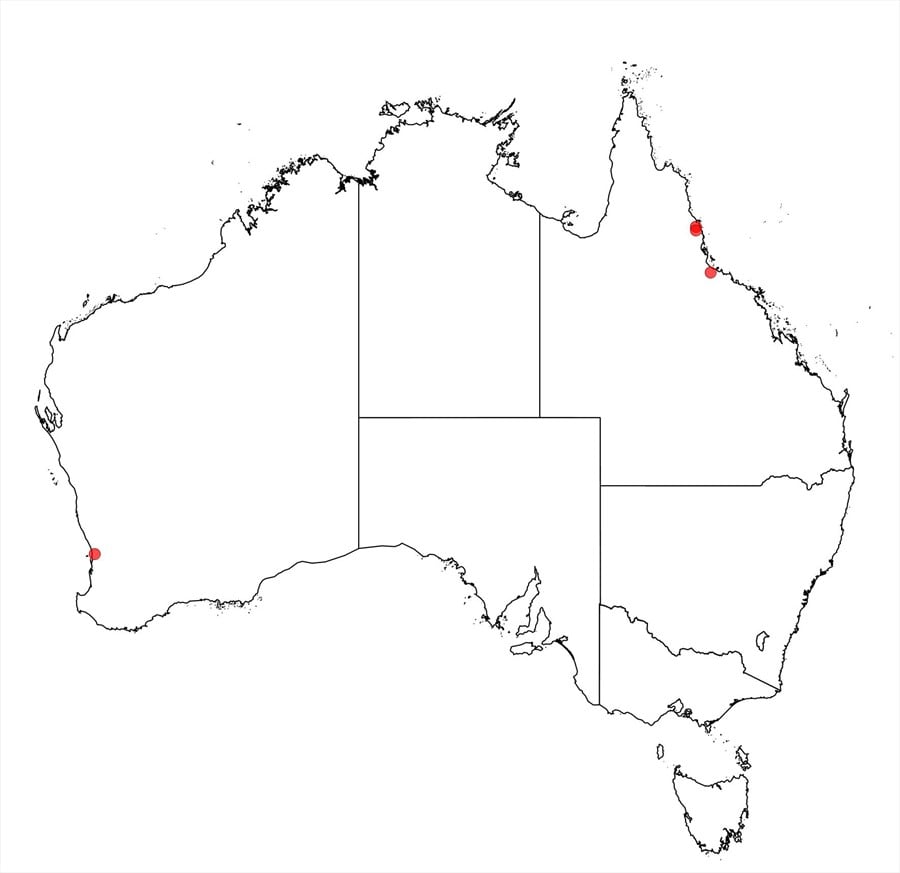Senegalia rugata (Lam.) Britton & Rose
WATTLE
Acacias of Australia
Family
Fabaceae
Distribution
This species is widespread in tropical SE Asia, including Papua New Guinea, fide I.C.Nielsen, Fl. Malesiana 11: 49 (1992). It is adventive in Australia where it is known from only two localities in north-eastern Qld; the Mossman plants were eradicated in 1974 because of their weed potential and a new population, at Gregory Falls (E of Innisfail), was discovered in 1998.
Description
Woody climber. Branchlets with patchy or sparsely distributed long weak crisped hairs, occasionally glabrous, with wide ribs and scattered, robust, recurved prickles up to 2 mm long along the ribs. Leaves: petiole 1.5–3.5 cm long, with an elliptic gland at about the middle; rachis (4–) 5–10 cm long, with scattered abaxial prickles on some leaves, gland present at base of uppermost pair of pinnae; pinnae 4–6 pairs, 3–7 cm long; leaflets 12–24 pairs per pinna, 6.5–9 mm long, 1.8–2.5 mm wide, oblong, ±obtuse, mucronulate, asymmetrically truncate at base, midrib oblique (arising at leading edge of leaflet and extending to about the middle of the leaflet at the apex), 3 or 4 lateral veins with distinct reticulum between them, with sparse long loose hairs on both surfaces or hairs confined to margins. Inflorescences single or in 2’s or 3’s in upper axils, the subtending leaves often not developing and heads forming a raceme or panicle; heads globular, 30–40-flowered; peduncles 1.5–3 cm long, indumentum similar to that of branchlets; buds red or purplish red, open flowers cream. Flowers 5-merous, sessile; calyx 1.5–3 mm long, shortly lobed, glabrous; corolla 2.5–3 mm long, lobed to about level of the calyx. Pods and seeds not seen.
Specimens
Qld: Rocky Point area, c. 11 km N of Mossman, 19 Sept. 1974, A.J.Twomey s.n. (BRI 185989); Gregory Falls, Reserve 842 Parish of Johnstone, B.P.M.Hyland 13817 (BRI, ex QRS – distributed as Acacia albizioides).
Notes
As noted by L.Pedley (l.c.) there is an entity of uncertain taxonomic status from the Townsville-Ayr region and the Mulgrave valley (a little S of Cairns), Qld. It differs from S. rugata as described above in having more pinnae and more leaflets per pinna, and its leaflets have a less distinct venation, are shortly appressed pubescent beneath and have a short but distinct petiolule (0.4 mm long). It is described by collectors as a bush or climber and occurs in open forest, not rainforest as does S. rugata. Material of this entity match a collection from Guangdong Prov., China, received at BRI as “Acacia sinuata”.
Based on molecular and other data Acacia sens. lat. is now considered as comprising a number of segregate genera, see J.T.Miller & D.S.Seigler, Austral. Syst. Bot. 25: 217-224 (2012) for overview. Many taxa in the former Acacia subg. Aculeiferum are now referable to the genus Senegalia, including the one presented here.
This species was not included in the Fl. Australia 11A (2001) but it was treated, as A. sinuata, by L.Pedley in B.R.Maslin (coordinator), WATTLE Acacias of Australia CD-ROM (2001).
As discussed by I.C.Nielsen, Adansonia 19(3): 349 (1980), the entities described as Acacia rugata and Acacia concinna have at times been treated as separate species or as varieties of the one species, but he considered that they are conspecific and correctly applied the name A. concinna to the combined entity. Under Senegalia, however, the correct name for this entity is S. rugata (see synonymy above). I.C.Nielsen (Adansonia 19(3): 349 (1980)) provisionally referred A. sinuata to A. concinna.
FOA Reference
Flora of Australia Project
Author
L.Pedley, B.R.Maslin
This identification key and fact sheets are available as a mobile application:
URL: https://apps.lucidcentral.org/wattle/
© Copyright 2018. All rights reserved.







